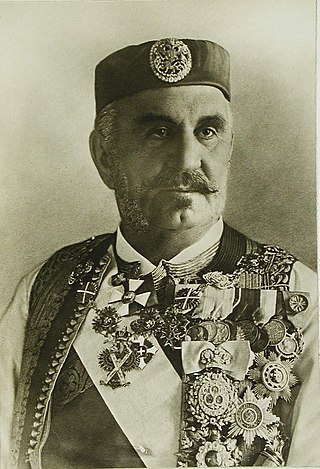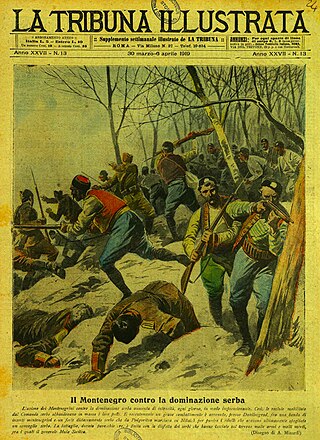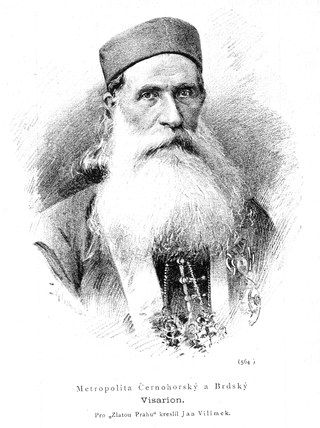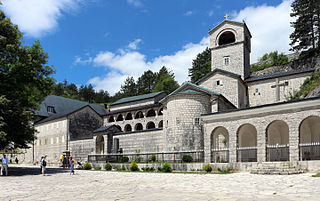Trešnjevo may refer to:
- Trešnjevo, Andrijevica, a village in Montenegro
- Trešnjevo, Cetinje, a village in the municipality of Cetinje, Montenegro
Trešnjevo may refer to:
Bata, Baťa, Baţa or Batá may refer to:

Petar II Petrović-Njegoš, commonly referred to simply as Njegoš (Његош), was a Prince-Bishop (vladika) of Montenegro, poet and philosopher whose works are widely considered some of the most important in Montenegrin and Serbian literature.

Cetinje is a town in Montenegro. It is the former royal capital of Montenegro and is the location of several national institutions, including the official residence of the president of Montenegro. According to the 2023 census, the town had a population of 12,460 while the Cetinje Municipality had 14,465 residents. Cetinje is the centre of Cetinje Municipality. The city rests on a small karst plain surrounded by limestone mountains, including Mount Lovćen, the legendary mountain in Montenegrin historiography. Cetinje was founded in the 15th century and became a cradle of the culture of Montenegro. Its status as the honorary capital of Montenegro is due to its heritage as a long-serving former capital of Montenegro.

Nikola I Petrović-Njegoš was the last monarch of Montenegro from 1860 to 1918, reigning as prince from 1860 to 1910 and as the country's first and only king from 1910 to 1918. His grandsons were kings Alexander I of Yugoslavia and Umberto II of Italy among others.

The Christmas Uprising, also known as the Christmas Rebellion, was a failed uprising in Montenegro led by the Greens in early January 1919. The military leader of the uprising was Krsto Popović and its political leader was Jovan Plamenac.
Konak may refer to:
Danilo Petrović-Njegoš may refer to:
Montenegro was independent from the Late Middle Ages until 1918, when it declared its union with Serbia and, subsequently, became part of various incarnations of Yugoslavia and the state union of Serbia and Montenegro. During this time, football in Montenegro was part of the wider Yugoslavian structures. As a result of the Montenegrin independence referendum held on May 21, 2006, Montenegro declared independence two weeks later, on June 3, and formed its own football association.

Visarion Ljubiša was the Serbian Orthodox metropolitan bishop of Montenegro from 1882 to 1884.

Mitrofan Ban was Bishop of Cetinje, Metropolitan of Montenegro, and exarch of the Serbian Orthodox Church. He was also Archimandrite of the Cetinje monastery. He presided over the Holy Bishopric Synod (1919-1920) that unified the Serbian Orthodox Church in 1920.

Milena Petrović-Njegoš was the only queen consort of Montenegro by marriage to Nicholas I of Montenegro.

The Cetinje Monastery is a monastery of the Serbian Orthodox Church in Montenegro. It is located in Cetinje and is the seat of the Metropolitanate of Montenegro. A center of historical and cultural importance, it was founded c. 1484 by Prince Ivan Crnojević of Zeta, and designated as the cathedral monastery of the Eparchy of Zeta. It was devastated in 1692, during the Morean War, and rebuilt between 1701 and 1704 by Metropolitan Danilo Petrović-Njegoš on the site of the former court of Ivan Crnojević.
Radomir may refer to:
Danilo Petrović may refer to:
The Vilayet of the Black Mountain was an Ottoman administrative unit within the Sanjak of Scutari, consisting of parts of modern-day Montenegro. It was established in the 16th century and existed until 1696. Although claimed by the Ottomans, the area was de facto independent with the Montenegrin tribes, with the support of the Metropolitanate of Cetinje, constantly waging wars against Turks.

The Montenegro national rugby team, known as the Wolves (Vukovi), represents Montenegro in rugby union. The sport of rugby has only come recently to the country since its independence in 2006. The squad plays in red and gold jerseys with red shorts, and their emblem is the double headed eagle while their logo is the wolf. Montenegro are currently in ENC 3 (European Nations Cup 3rd Division) for rugby union, competing for the first time as an independent country. The team was first guided and coached by Marty Lusty.
RTV Cetinje is the local public broadcaster in Cetinje, Montenegro. It broadcasts and produces news, cultural and sports programming through radio and the Internet.
It's the oldest electronic broadcaster in Montenegro, founded on 27 November 1944.
RTV Cetinje has three media services - Radio Cetinje, Internet television and Web portal.

Joanikije II is a Serbian Orthodox metropolitan bishop serving as the Metropolitan of Montenegro and the Littoral and the primate of the Serbian Orthodox Church in Montenegro since May 2021, previously he served as the administrator of the same diocese from October 2020, and death of his predecessor Amfilohije (Radović). Bishop Joanikije was the head of the Eparchy of Budimlja and Nikšić from 2002 until 2021 and titular bishop of Budimlja betweein 1999 and 2002.
Štitari may refer to: